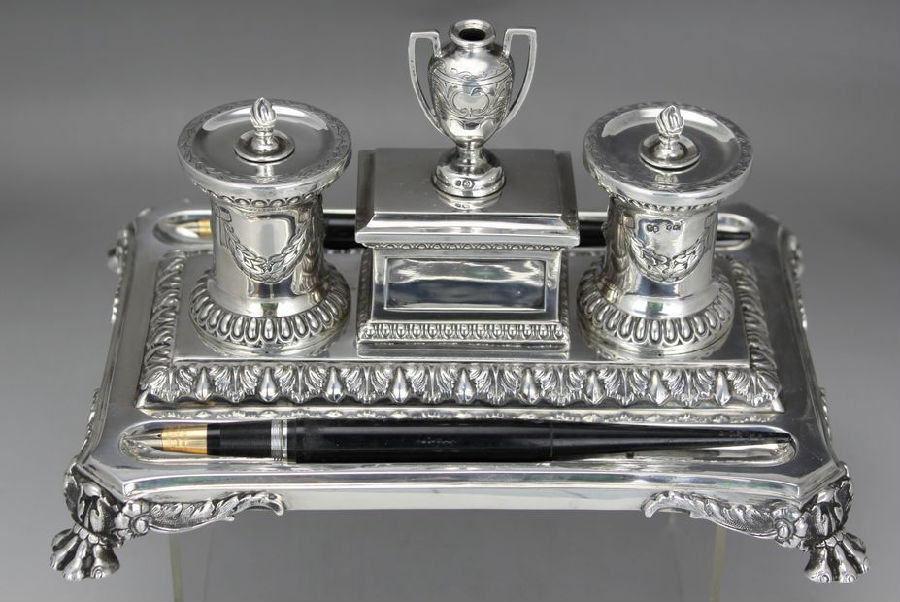This maiolica inkstand
這個于1500年在法恩扎
painted in Faenza around 1500
進行彩繪的馬爵利卡陶墨水臺
takes the marriage theme even further
進一步闡釋了愛情和婚姻的主題
It's divided into compartments
這個墨水臺分成兩個部分
for ink and writing equipment
分別放置墨水和書寫工具
At one end, visible in the image on the right is a band painted with
在其中一端 可以看到圖片右邊是一條帶子
the profile bust of a man and a woman facing one another
上面繪有一對面對面的男女的側面半身像

Both wear court dress of the period 1490-1506
兩人都穿著1490到1506年間的宮廷禮服
Her appearance closely
女性的表情
resembles that of a young amorous woman
很像可追溯到1499年的
on the front of a Valentine jug dated 1499
瓦倫丁水壺上所繪的熱戀中的少婦
shown here on the left
就是左邊的這個
which can also be seen in the exhibition
這個水壺也可以在這次的展覽中看到
Between the lovers is the familiar motif
在這對情侶之間有個很相似的主題
the "fede" or clasped hands
忠貞或者說緊握的雙手
surrounded by fluttering ribbons
由飛舞的絲帶和意大利語題字環繞著
and the legend in Italian
上面寫著
"I give you my hand, give me the ring"
我伸出我的手 請給我戴上戒指
The paired profiles of the couple, gazing towards one and other
這對夫婦的側面圖中 他們凝望著對方
echo that in paired panel portraits
和本次展覽中
that can be seen in the exhibition
可以看到的面板畫像 相互呼應
The "fede" motif, and the inscription
忠貞的主題和文字
make the end iconography explicit
讓最終的圖像
in referring to the marriage vow
暗示了婚姻誓言
and the gift of a ring, fede, to signify it
和象征忠貞的結婚禮物 戒指
The signing of the contract, or scritta
婚約的簽署或兩個家族之間的協議
between two families was the key element in elite marriage rituals
是統治精英婚俗禮節中的重要組成部分
It's a plausible hypothesis that
這是一種
this ink stand might have been intended
似是而非的假說
to be used at the signing of a marriage contract
認為這個墨水臺可能用于在公證人面前
before the exchange of vows before a notary
交換誓言之前婚約的簽署
It's the only one that can be linked tentatively to
只有這個暫且能夠
the marriage ceremony through
通過主題和文字
both its iconography and inscription
與婚禮聯系起來
The profiles of
在馬爵利卡陶瓷中
a couple can be paired
一對相互對視的夫婦的側面圖
facing one another in various ways on maiolica
能夠以多種方式呈現出來
the busts of heros and heroines in classical antiquity
在經典古董上的男女主角的半身像
or characters from literature and legend
或者文學和文字中的人物
made popular themes for decorating sets of
成為了頗為流行的馬爵利卡陶瓷餐具
maiolica dining dishes
裝飾圖案的主題
particularly in Urbino and Castel durante
尤其是在16世紀早期的
in the early decades of the 16th century
烏爾比諾和卡斯特杜蘭特
They usually present metal
它們通常體現的是
like busts of famous heroes and heroines
源于歷史和傳奇故事的男女主角
and famous characters from history and romance
和著名人物的金屬半身像
such as Ruggieri and Philomena
如羅明堅和菲洛米娜
here dating from 1520-5
這個可以追隨到1520到1525年間
Next are two variants on the theme
下面是這一主題的兩個變體
one in the British Museum
一個來源于大英博物館
and a related piece in a private collection
另外一個則是一個私人收藏品中的相關器件
On the one on the right, is a young man
右邊的這個 描繪的是一個年輕小伙
accompanied by a scroll reading "Lutio, 1524"
他旁邊的卷軸記載著 "魯西奧 1524"的字樣
On the other bowl on the left
而左邊的另外一個碗上面
a woman's head faces right
描繪的是一個臉向右看的婦女的頭像
with the legend, "Divine Silvia"
旁邊的題字是 "神圣的西爾維婭"
both wear contemporary costumes
兩者都穿著當時的服飾
with similar detailing
兩件衣服在細節上有多個相似之處
such as the smocked embroidered shirts
如都有繡花的罩衫
both pieces share the same script
兩件還都有同樣的字跡
and common date 1524
和共同的日期1524年
and it's being suggested that they're intended to be
據猜測 它們的目的是暗示
viewed as a couple facing one another in display on a buffet
就餐時相互對視的夫婦
Silvia and Lutio stand out for the fact that they wear
西爾維婭和魯特西奧明確表明
meticulously represented contemporary dress
他們那精心打扮的裝束體現的是當時的服飾
They have contemporary names
他們還擁有當時的名稱
and they bear the same date
以及并記載著同樣的日期
These variations from the rules suggest that
這些源于規則的變化表明
they may be intended as representations of a living couple
它們用來表示仍在世的夫婦
The way in which one image relates to another
一種圖像和另一個圖像相關聯的方式
both in terms of composition and psychological insight
兩者在組成和心理洞察力方面
distantly echoes developments in contemporary painted portraits
和當代的繪畫肖像的發展遙相呼應
and you can see in the exhibition
這可以在本次展覽中看到











